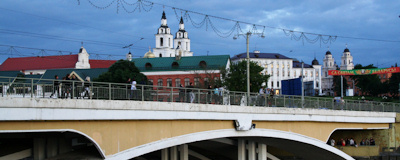

The public space of Minsk is structured by power practices and discourses. Only the official events – mostly entertaining and ideologically “correct”, for instance parades, celebrations, concerts fairs and other, can take place publicly here. The public space is filled with screens that ceaselessly project images (the news of the state TV channel, music videos and commercials) and big social advertising billboards with portraits of people who clearly represent positive social roles, as well as slogans like “For Belarus!”, “Belarus for the people”, “We are Belarusians”, “For heroic Belarus”. There is practically no place for the unofficial in the public space, and it is de facto illegitimate. After the peaceful manifestation of the recent years (the silent protest actions, for instance), unsanctioned gatherings of citizens (more than 3 persons) or any form of “organized activity or inactivity with the purpose of public expression of one’s views” have been outlawed, and are now punishable by fines or several days of arrest. The state authorities find numerous ways of preventing unofficial events from happening, such as occupying the public space by concerts, which the members of patriotic organisations are obliged to attend, or physically filling the public space with fencing or road washer vehicles that wash the streets of the city even in the rain.
The possible artistic strategies that could help the unofficial statement take place publicly could be those of small actions happening sporadically in different spots of the city, or artistic actions taking place in the zones located in between the public and private spaces, such as yards, unlit streets of suburban districts and stairwells, or those of imitating/mocking the governmental practices through mimicry actions that could be misidentified as official/safe (for instance, Marina Naprushkina’s walk through the city with a portrait of Lukashenko). The main objective of such actions would be to create space for something other than the official statement to happen publicly. Therefore, the Habermasian vision of public space (coincidentally, this thinker’s ideas are particularly popular in the Belarusian intellectual community) cannot serve as a point of reference here. In Minsk’s public space, rational consensus achieved through reasonable communication is hardly possible. In this context, it can prove useful to take into account the public space theory of Chantal Mouffe (a critic of the Habermasian notion of public space), who perceives it as a dynamic space of agonistic encounter of hegemonic political projects, in which there is no place for reconciliation. Ideally, the public space, or, rather, public spaces of Minsk should become places where conflicts between various statements / enunciations can happen. What is important in this case is not so much to imagine the ideal discursive situation but to give voice to different statements, including those that are not imbued with authority. Artistic statements in the public space of Minsk are crucially important primarily because the very fact of their taking place creates (in the words of Saskia Sassen) modest political spaces of intervention. Consequently, an artistic statement in the public space, even if it is spontaneous, short-term and almost imperceptible, reclaims the public space for statements. In other words, artistic statements taking place in the public space make it possible for statements as such to happen there. In a situation where the very presence in the public space is illegal, and any statement in the public space turns out to be illegitimate, regardless of its actual content (including even the silent ones), artistic attempts to reclaim the public space of Minsk are now more than relevant.
Aliona Gloukhova
